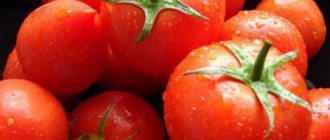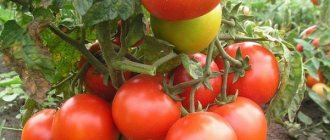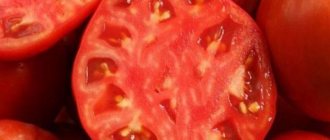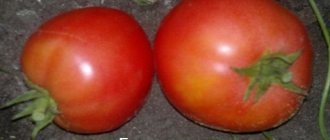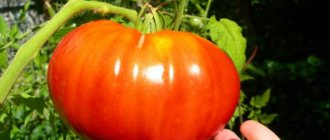Tomato Gulliver F1 is a favorite of many gardeners and professional farmers. The variety has many bonuses - a delicious taste, an abundance of tomatoes of the same size, which is convenient for winter preparations.
| Height | Landing location | Ripening time | Fruit color | Fruit size | Origin | Fruit shape |
| Medium height | Greenhouse, Open ground | Mid-season | Reds | Average | Variety | Plum-shaped or oval |
Tomato Gulliver: variety description
| Variety name | Gulliver |
| general description | An early-ripening, determinant, high-yielding hybrid of Russian selection for cultivation in greenhouses and open ground. |
| Originator | Russia |
| Ripening period | 95-100 days |
| Form | Fruits are elongated with a rounded tip |
| Color | Red-pink |
| Average weight of tomatoes | 200 grams |
| Application | The variety is suitable for preparing salads, soups, sauces, juices, canning |
| Productivity of the variety | 7 kg per bush |
| Features of cultivation | Standard agricultural technology |
| Disease resistance | The hybrid resists major diseases well, but preventive measures will not hurt |
A variety of Russian selection, intended for growing in greenhouses made of polycarbonate or glass, in greenhouses and under film.
In regions with warm climates, planting in open ground is possible. The collected fruits are stored well and can withstand transportation without problems. Gulliver is a high-yielding early-ripening variety. The bushes are determinate, compact, up to 70 cm high. Read about indeterminate varieties here. Leaf mass is moderate.
It is recommended to form 2 or 3 stems using pinching; heavy branches with fruits require tying. Tomatoes ripen at the same time, fruiting lasts from July to September. The yield is very good; with proper care, up to 7 kg of tomatoes can be removed from the bush.
You can compare the yield of this variety with others in the table below:
| Variety name | Productivity |
| Gulliver | 7 kg per plant |
| Polbig | 4 kg per plant |
| Kostroma | 5 kg per bush |
| Lazy | 15 kg per square meter |
| Fat Jack | 5-6 kg per plant |
| Lady Shady | 7.5 kg per square meter |
| Bella Rosa | 5-7 kg per square meter |
| Dubrava | 2 kg per bush |
| Dad | 6 kg per bush |
| Pink spam | 20-25 kg per square meter |
Further care of plants
Further care for the Gulliver tomato consists of regular watering, loosening the root zone, weeding and fertilizing.
Irrigation regime
After replanting, watering the tomato bushes is carried out once every 3-4 days, and the soil should be moistened to a depth of 0.3-0.4 m. In hot times, the number of waterings is increased, and in rainy times, reduced.
Important! Water for irrigation should be settled and warm. Cold moisture can trigger the development of root rot.
Loosening and weeding
The root zone of tomato bushes should be loosened after each watering or rain. At the same time, all weeds are removed.
You can make it easier to care for the soil in your garden beds by regularly adding mulch. A layer of straw, grass or rotted sawdust does not allow moisture to quickly evaporate from the soil, and weeds grow worse in such conditions.
Interesting article:
The best early varieties of sweet peppers for open ground
Gulliver tomato shoots should be tied up so that they do not break off under the weight of ripening fruits, and supports are also placed under the clusters with fruits.
Feeding tomato bushes
Tomato Gulliver responds well to the addition of organic matter
. Therefore, it is best to apply a solution of cow manure diluted with water in a ratio of 1:5 under the bushes of these tomatoes.
You can also use a solution of chicken manure
, diluted with water in a ratio of 1:15 (after infusing it for 5 days in a warm place).
Many vegetable growers use greenfinch to feed tomatoes.
. To do this, a 10-liter tank is filled approximately 2/3 with mowed grass, filled to the brim with water and infused for a week. Then half a liter of infusion is poured into a bucket of water and 500 ml of the resulting fertilizer is added to each bush.
After the ovaries appear on the bushes, the tomato bushes should be fertilized with complex fertilizers for tomatoes. Such preparations must be diluted according to the attached instructions; the dosage of fertilizers must not be exceeded.
Tomato Gulliver: photos and reviews
Characteristics
Among the main advantages of the variety:
- tasty and beautiful fruits;
- good yield;
- tomatoes are suitable for salads and canning;
- disease resistance;
- undemanding to growing conditions.
The variety has practically no disadvantages. The only difficulty is tying up heavy branches that can break under the weight of the fruit.
Fruit characteristics:
- The fruits are large, fleshy, very beautiful.
- The average weight of a tomato is about 200 g, but larger specimens up to 800 g often ripen.
- During the ripening process, the color changes from light green to rich red-pink.
- The tomatoes are elongated, cylindrical, with a rounded tip.
- The pulp is tender, juicy, sugary, the seed chambers are small.
- The thick, glossy skin protects the fruit from cracking.
You can see the weight of fruits of other varieties in the table below:
| Variety name | Fruit weight |
| Gulliver | 200 grams |
| Red Guard | 230 grams |
| Diva | 120 grams |
| Yamal | 110-115 grams |
| The Golden Fleece | 85-100 grams |
| Red Arrow | 70-130 grams |
| Raspberry ringing | 150 grams |
| Verlioka | 80-100 grams |
| Countryman | 60-80 grams |
| Caspar | 80-120 grams |
The variety is suitable for preparing salads, soups, sauces, and juices. Smooth tomatoes with thick skin are good for canning; they are salted, pickled, and dried.
Advantages and disadvantages of the variety
Each new type of tomato developed aims to improve almost all characteristics, from agrotechnical to taste. However, even modern breeding cannot remove all minor defects.
Gulliver tomatoes are not the juiciest representatives of their kind
pros
- original appearance of the fruit;
- dense pulp;
- ease of care;
- excellent taste;
- drought resistance;
- immunity to many fungal diseases.
Minuses
- relative dryness of fruit pulp;
- low yield;
- narrow zoning of the variety.
Features of cultivation
Seeds are sown for seedlings in early March; 60-70 days should pass before transplanting into the ground. Light soil made from a mixture of garden soil with peat or humus is preferable. Before planting, seeds are soaked in a growth stimulator and sown at a depth of 2 cm.
Most often they are sown in a container, but it is also possible to plant them in small peat pots. Individual packaging eliminates subsequent picking. For better germination, the containers are covered with film and placed in a warm place. You can use special mini-greenhouses.
After sprouting, tomatoes require bright light. In cloudy weather, seedlings are illuminated with electric lamps. The sprouts are watered with warm, settled water, preferably from a spray bottle or a fine-mesh watering can. After unfolding 2-3 sheets, picking is carried out. The seedlings are fed with liquid complex fertilizer, the second feeding is carried out before transplanting to a permanent place.
Plants should be planted in the greenhouse in the second half of May. Pour 1 tbsp into each well. spoon of complex mineral fertilizers. During the season, plants are fed 3-4 times, alternating potash and phosphorus fertilizers with organic matter. Read how to prepare soil in a greenhouse here. As for fertilizing, they use:
- Yeast.
- Iodine.
- Hydrogen peroxide.
- Ammonia.
- Ash.
- Boric acid.
Watering is carried out every 6-7 days; in between, the top layer of soil should dry out. As the fruits ripen, the branches are tied to a support. For successful formation of ovaries, it is recommended to form a bush with 2 or 3 stems.
How to grow seedlings
Sowing seeds for seedlings begins 2 months before planting in the ground. Before sowing, the seeds undergo special treatment to improve germination.
Seed preparation
Planting material is checked for germination by placing the grains in a saline solution for 10 minutes. Seeds that float to the surface are not suitable for planting.
Seeds collected independently are subject to mandatory disinfection before sowing. To do this, they are placed in a weak solution of potassium permanganate for 20 minutes.
Reference . Seed material purchased from a specialized store does not need to be processed. The originator took care of everything himself.
After disinfection, the grains are washed with running water, wrapped in gauze, slightly moistened and left in a warm place for 2-3 days for germination. The room temperature must be at least 23°C. After the sprouts appear, the grains are ready for sowing.
Reference . Gulliver tomato seeds are produced by Agro and Siberian Garden.
Container and soil
The soil mixture is prepared from garden soil, humus and wood ash. All components are thoroughly mixed and poured with a hot solution of pink potassium permanganate to destroy pathogenic flora.
They are planted in separate containers or in a common wooden box, in which holes are first made in the bottom so that when watering there is no stagnation of excess moisture. If you sow seeds directly into peat pots, there is no need to pick seedlings later. In addition, during transplantation, seedlings are planted in the ground along with peat pots, which dissolve in the soil without harming the root system.
Planting containers are filled halfway with prepared soil. Later, as the young bushes grow and develop, the remaining soil is poured into the containers. This way the seedlings receive more nutrients.
Sowing
The seeds are sown in furrows 1.5-2 cm deep, making the row spacing 3 cm. If the grains are sown shallow, they will germinate along with the shell, which will slow down their further growth. After sowing, the soil is slightly moistened with a spray bottle and left in a warm and bright room at a temperature of at least 22°C. Planting containers are covered with film or glass to create a greenhouse effect.
Philodendron: plant types and features of growing at home
Growing and care
After the first shoots appear, the containers are moved to a more illuminated place, for example, on a windowsill.
Reference . Avoid exposure to direct sunlight. Young shoots can suffer serious burns.
Water as needed with warm, settled water using a shallow watering can along the edge of the nursery. After watering, the soil is loosened superficially for better oxygen saturation.
When 2 true leaves appear, the seedlings are picked and placed in separate containers. If the seedlings are left in a common box, the distance between plants is maintained at least 10 cm. After picking, the seedlings are shaded for 1-2 days, then moved again to a well-lit place.
2 weeks before planting in open ground, seedlings begin to harden. This technique strengthens the immunity of seedlings and promotes faster adaptation to outdoor conditions. The hardening process involves keeping the seedlings outdoors for 25-45 minutes every day. Gradually, this time is increased to 12 hours, while simultaneously reducing the night temperature in the room where the seedlings are brought to 13°C.
Pests and diseases
The variety is insensitive to fungal and viral diseases. However, when plantings are thickened, infections are possible. Frequent ventilation, removing the lower leaves on the bush and mulching the soil will help prevent them.
It is useful to spray young plants with phytosporin, a pale pink solution of potassium permanganate and copper-containing preparations. Dried or damaged leaves and fruits are immediately destroyed.
In greenhouses, plants can be affected by aphids, thrips or spider mites. Ventilation and timely destruction of weeds will help prevent the appearance of pests.
Plants affected by aphids are washed with a warm soapy solution; insecticides will help destroy the mite. Treatment is carried out 2-3 times with an interval of several days. After the start of fruiting, the use of toxic drugs is prohibited.
Read more on our website: What diseases most often threaten tomatoes in greenhouses and how to fight them? Which varieties are resistant to late blight, what kind of disease is it and how to protect yourself from it? What are the dangers of Alternaria, Fusarium, Verticillium and which varieties are not susceptible to these scourges?
Gulliver is a good choice for owners of greenhouses and greenhouses. Tomatoes need timely feeding and staking; with proper care, the plants will reward you with an excellent harvest.
Harvesting and application
The ripening of fruits is friendly - this is an important distinguishing feature of Gulliver. It is not necessary to wait for vegetables to fully ripen; they can gain color on their own at room temperature within a few days. Placing unripe tomatoes next to ripe ones will speed up the time for self-ripening.
When the air temperature is 10°C and below, vegetables are harvested green. Cold nights promote the development of fungal diseases and rotting vegetables. In any case, tomatoes in the garden beds will not be able to ripen at this temperature.
Universal use in cooking. Ripe vegetables are ideal for fresh salads and other vegetable dishes. Smaller tomatoes are used in whole-fruit canning. They do not lose their taste in pickles and marinades and are excellent for making tomato products: paste, ketchup, sauces, juices.
An important property of ripe vegetables is that they can withstand heat treatment without cracking. Thanks to this, they are dried in the oven at low temperatures or in the sun. Tomatoes are also dried and frozen.
Tomatoes are subject to long-term storage for 4 weeks without loss of external and taste qualities. Excellent resistance to long-term transportation.
The universal purpose allows you to use tomatoes for preparing salads, sauces, and juices. Smooth fruits with thick skin are suitable for canning, pickling, pickling, and drying.
Proper care will allow you to harvest from 3 to 4 kg of tomatoes from one plant.
The tomato variety "Gulliver" is recommended for cultivation in the Central Black Earth region (Belgorod, Voronezh, Kursk, Lipetsk, Oryol and Tambov regions). However, tomato is successfully cultivated in the middle zone.
The ripening of fruits is friendly - this is an important distinguishing feature of Gulliver. It is not necessary to wait for vegetables to fully ripen; they can gain color on their own at room temperature within a few days. Placing unripe tomatoes next to ripe ones will speed up the time for self-ripening.
Useful video
The following video explains how to properly form a tomato bush in a greenhouse. It will be useful for gardeners who decide to grow Gulliver tomatoes.
In the table below you will find links to other tomato varieties with different ripening periods:
| Mid-season | Mid-late | Mid-early |
| Marshmallows in chocolate | French grape | Pink Bush F1 |
| Gina TST | Golden Raspberry Miracle | Flamingo |
| Striped chocolate | Miracle of the market | Openwork |
| Ox heart | gold fish | Cio Cio San |
| Black Prince | De Barao Red | Supermodel |
| Auria | De Barao Red | Budenovka |
| Mushroom basket | De Barao Orange | Major F1 |
If you find an error, please select a piece of text and press Ctrl+Enter.
Farmer reviews
Nikolay, Yekaterinburg: “The description says that tomatoes can only be grown in the Central Black Earth Region. I decided to take a risk. I sowed 5 seeds and they all sprouted. The seedlings grew well. After planting in the ground, the bushes quickly adapted. They did not require any special attention other than normal care. Almost all the flowers bore, there was a lot of fruit. I will grow more."
Violetta, Barnaul: “I grow various vegetables, including tomatoes. I buy Gulliver seeds. Tasty, neat fruits are enjoyed fresh or canned. I didn’t observe any diseases during the growing season.”
Violetta, Barnaul: “I grow various vegetables, including tomatoes. I buy Gulliver seeds. Tasty, neat fruits are enjoyed fresh or canned. I didn’t observe any diseases during the growing season.”
An early-ripening, determinate, medium-growing, cluster tomato variety for open ground and film shelters.
Bush 0.7-1.2 meters high, requiring support. The manufacturer does not recommend pinching the plant, but we got the best results when forming it into 3 stems. In order to get 3 trunks, leave one stepson each - before and after the first flower cluster.
The fruits are slightly elongated cream, smooth, with dense skin, red in color at maturity, weighing up to 100 grams, excellent taste (which is rare for early varieties). The pulp is aromatic and has few seeds. These tomatoes are universal in purpose - good for both whole-fruit canning and fresh consumption, making juices and sauces.
Thanks to early ripening and smooth ripening, the tomato avoids late blight.
This tomato variety is included in the State Register for the Central Black Earth Region for cultivation in open ground on private farms.
The tomato variety "Gulliver" is loved by most gardeners. The tomato has captivated farmers with its ease of care, excellent immunity, and excellent taste characteristics.
Tomato "Gulliver" will be an excellent choice for owners of personal plots. As with growing any tomato variety, “Gulliver” needs timely feeding and staking. If you provide additional care, you will certainly be surprised by a good harvest.


